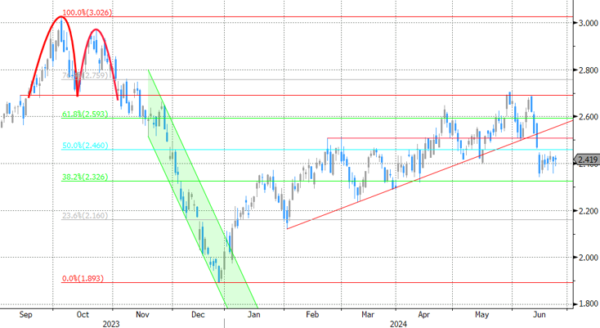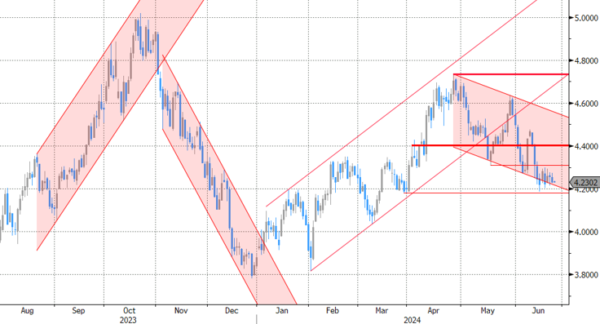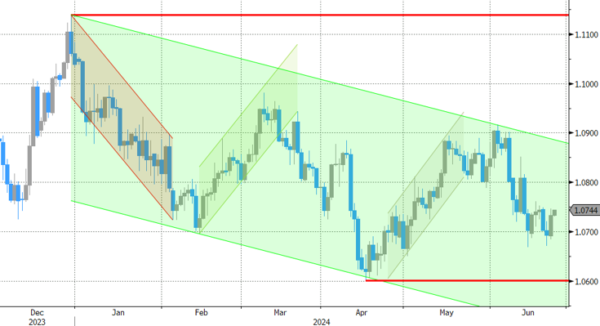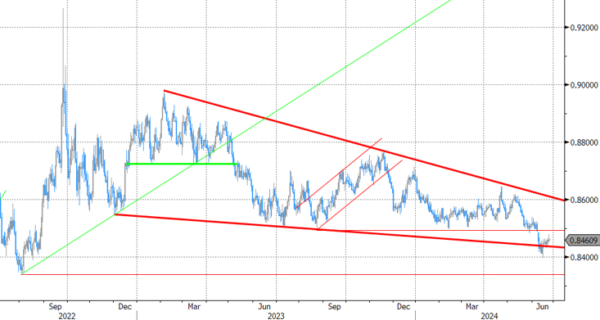Markets
Fuss about potential Japanese FX interventions (USD/JPY 160) and more French political scenario’s dominated headlines yesterday, but failed to inspire trading. European risk sentiment improved with key indices rising by 0.5% to 1.5%. Safe haven assets like core bonds and the dollar travelled the other direction, resulting in marginally higher German yields and EUR/USD reconquering 1.07 (close 1.0733). Sentiment soured after European close with AI-darlings correcting from recent record races. The S&P 500 (-0.3%) and Nasdaq (-1.1%) ended with losses, fueling a late bid in US Treasuries. Comments by San Francisco Fed Daly (voter this year) were interesting. She stressed that at this point, inflation is not the only risk that the Fed faces. Daly admits that the labour market so far adjusted slowly with the unemployment rate only edging up. She fears though that we are getting nearer to a point where that benign outcome could be less likely. “Future labour market slowing could translate into higher unemployment, as firms need to adjust not just vacancies, but actual jobs”. Daly urged policy makers to remain vigilant to both inflation and labour market risks. If inflation falls more slowly than expected, Daly said it would be appropriate to hold interest rates higher for longer. If inflation falls quickly or the labor market cools more than expected, cutting rates would be necessary. From a risk/positioning point of view, we follow Daly’s reasoning. The bumpy inflation path ahead certifies the June FOMC dot plot calling for only one policy rate cut this year. A sudden weakening of the labour market is a bigger risk to this scenario that the inflation path.
Today’s eco calendar is empty in Europe. Some ECB members speak, but the focus gradually turns to next week’s Sintra symposium, the ECB’s equivalent of the end of August Jackson Hole meeting by the Fed. The US calendar is more interesting with house prices, Richmond Fed manufacturing index and especially consumer confidence. Speeches by Fed Bowman and Cook and the start of the US Treasury’s end-of-month refinancing operation serve as a wildcard. Going into Friday’s PCE deflators and with the end of quarter looming, we err on the side of a decent bid for US Treasuries. A bigger correction in (US) tech stocks would also fit this view. Together with this weekend’s French elections is why we stick to the view that EUR/USD has little upward/rebound potential even in case of softer US data. Intervention bells in USD/JPY (159.42) are still ringing.
News & Views
Australian consumer confidence as measured by the Westpac-Melbourne Institute improved modestly in June rising from 82.2 to 83.6, but remains well below the 100 level that signals the balance between pessimists and optimists. According to comments from Westpac, “the survey detail suggests positives from fiscal support measures are being negated by increased concerns about inflation and the outlook for interest rates”. Fiscal support measures made consumers turning more positive on current and future family finances. They also showed more preparedness to buy major household items. At the same time, consumers turned much more negative on the economy for the next year (-5.7%). Also intentions to buy a dwelling declined substantially. The survey comes as the Reserve bank of Australia at its June 19 meeting indicated that inflation has been easing more slowly than expected and that it remains prepared to do what is necessary to bring inflation back to target. The Aussie dollar continues trading in a tight range between 0.6575 and 0.6715 (currently 0.6665).
Argentina entered a technical recession in the first quarter of this year. Activity contracted 2.6% Q/Q after a decline of 2.5% in the final quarter of last year. Activity in Q1 was 5.1% lower compared to the same period last year. The recession comes as president Milei tries to restore public finances via aggressive spending cuts. Private consumption declined 6.7% Y/Y. Also public consumption was 5% lower. Imports shrank by 20.1% while exports rose 26.1%. Due to the contraction in activity the unemployment rate rose from 5.7% in Q4 2023 to 7.7%.
Graphs
GE 10y yield
The ECB cut its key policy rates by 25 bps at the June policy meeting. A more bumpy inflation path in H2 2024, the EMU economy gradually regaining traction and the Fed’s higher for longer US strategy make follow-up moves difficult. Markets are coming to terms with that. For the time being, though, the political narrative (France) dominates. After hitting a new YtD top at 2.7%, the German 10-yr yield corrected lower on safe haven bids.
US 10y yield
The Fed is seeking more evidence than just one slower-than-expected (May) CPI is providing. Upgraded inflation forecasts and a higher neutral rate complicate the exact timing of a first cut further. June dots suggest one move in 2024 followed by four more next year. Markets are positioned more aggressively, turning the recent low in yields into a technical support zone. The US 10-y yield is testing the downside of the 4.2/4.7% trading range.
EUR/USD
EUR/USD is stuck in the 1.06-1.09 range. The desynchronized rate cut cycle with the ECB exceptionally taking the lead, strong US May payrolls and a swing to the right in European elections pulled the pair away from 1.09 resistance. The Fed meeting balanced the weaker than expected US CPI outcome. Euro fragility makes a return to the 1.06 downside more likely than not.
EUR/GBP
Debate at the BOE is focused at the timing of rate cuts. May headline inflation returned to 2%, but core measures weren’t in line with inflation sustainably returning to target any time soon. Still some BoE members at the June meeting appeared moving closer to a rate cut. This might cap further sterling gains. At the same time, the euro remains vulnerable to political event risk going into the French elections. EUR/GBP 0.84 is becoming solid support.

















